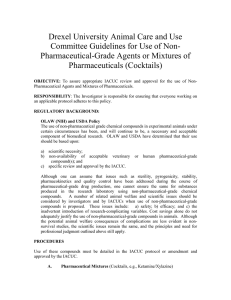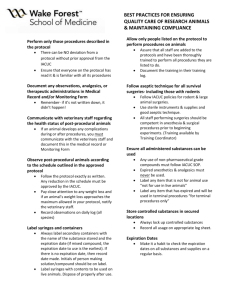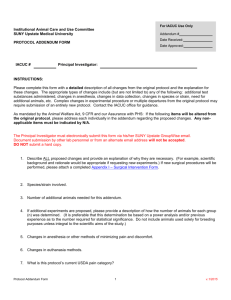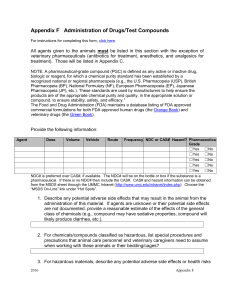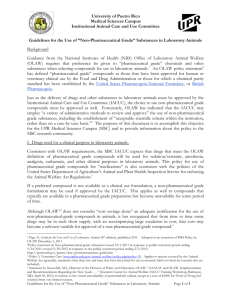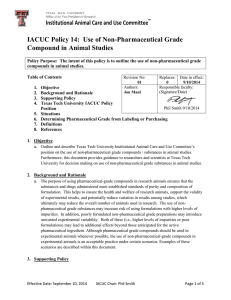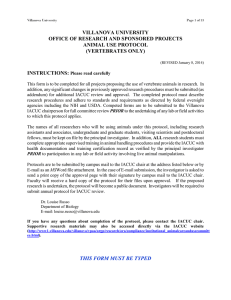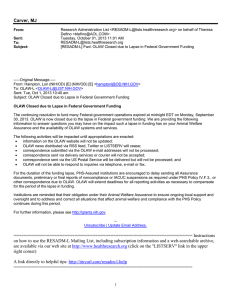Guidelines for the Use of Non-Pharmaceutical
advertisement
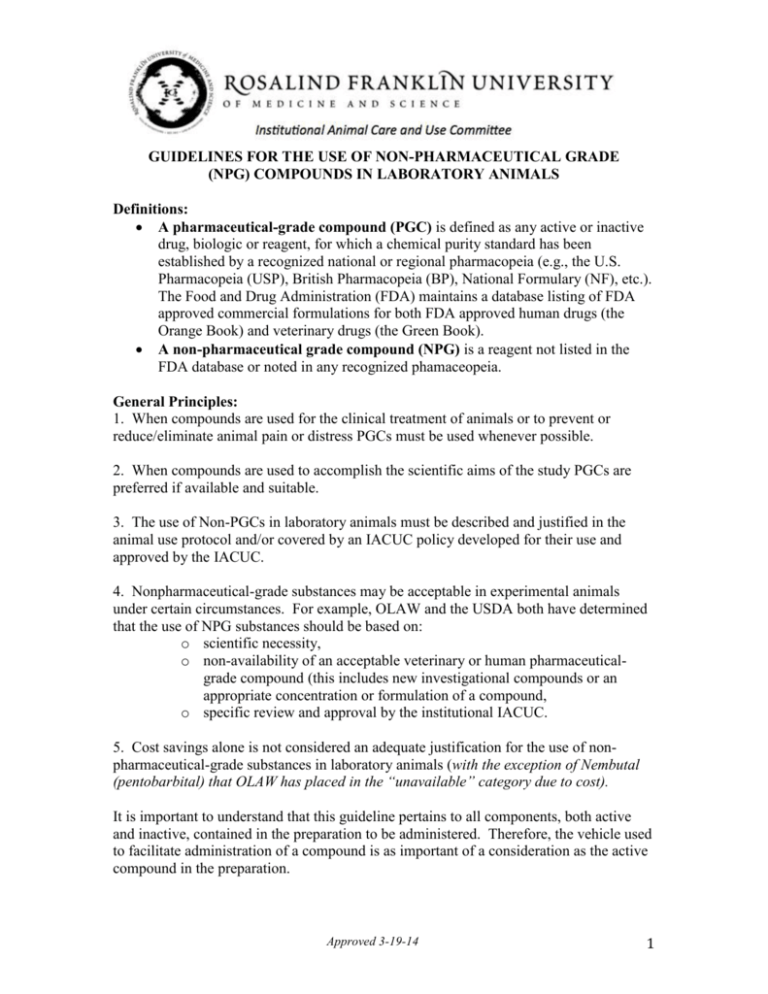
GUIDELINES FOR THE USE OF NON-PHARMACEUTICAL GRADE (NPG) COMPOUNDS IN LABORATORY ANIMALS Definitions: A pharmaceutical-grade compound (PGC) is defined as any active or inactive drug, biologic or reagent, for which a chemical purity standard has been established by a recognized national or regional pharmacopeia (e.g., the U.S. Pharmacopeia (USP), British Pharmacopeia (BP), National Formulary (NF), etc.). The Food and Drug Administration (FDA) maintains a database listing of FDA approved commercial formulations for both FDA approved human drugs (the Orange Book) and veterinary drugs (the Green Book). A non-pharmaceutical grade compound (NPG) is a reagent not listed in the FDA database or noted in any recognized phamaceopeia. General Principles: 1. When compounds are used for the clinical treatment of animals or to prevent or reduce/eliminate animal pain or distress PGCs must be used whenever possible. 2. When compounds are used to accomplish the scientific aims of the study PGCs are preferred if available and suitable. 3. The use of Non-PGCs in laboratory animals must be described and justified in the animal use protocol and/or covered by an IACUC policy developed for their use and approved by the IACUC. 4. Nonpharmaceutical-grade substances may be acceptable in experimental animals under certain circumstances. For example, OLAW and the USDA both have determined that the use of NPG substances should be based on: o scientific necessity, o non-availability of an acceptable veterinary or human pharmaceuticalgrade compound (this includes new investigational compounds or an appropriate concentration or formulation of a compound, o specific review and approval by the institutional IACUC. 5. Cost savings alone is not considered an adequate justification for the use of nonpharmaceutical-grade substances in laboratory animals (with the exception of Nembutal (pentobarbital) that OLAW has placed in the “unavailable” category due to cost). It is important to understand that this guideline pertains to all components, both active and inactive, contained in the preparation to be administered. Therefore, the vehicle used to facilitate administration of a compound is as important of a consideration as the active compound in the preparation. Approved 3-19-14 1 OLAW has also stated that while the possible implications of the use of nonpharmaceutical grade substances in nonsurvival studies appears less evident, the scientific issues remain the same and professional judgment, as outlined above, must still apply. Acceptable scientific justifications for the use of non-pharmaceutical-grade compounds that the IACUC considers: 1. No equivalent veterinary or human drug is available for experimental use. The highest-grade equivalent chemical reagent should be used and formulated aseptically, with a non-toxic vehicle, as appropriate for the route of administration. 2. Although an equivalent veterinary or human drug is available for experimental use, the chemical grade reagent might be required to replicate methods from previous studies if it is the only option to produce results that are directly comparable. 3. Although an equivalent veterinary or human drug is available, dilution or change in formulation is required. If the formulation as provided must be diluted, altered by addition, or otherwise changed, there may be no additional advantage to be gained by using the USP formulation. In this situation, use of the highest grade reagent may have the advantage of single-stage formulation and also result in purity that is equal to or higher than the human or veterinary drug. Professional judgment should be used to determine the appropriate test material and to ensure use of an agent with the least likelihood for causing adverse effects. 4. The available human or veterinary drug is not concentrated enough to meet experimental requirements. 5. The available human or veterinary drug does not meet the non-toxic vehicle requirements for the specified route of administration. References: U.S. Department of Agriculture, Animal and Plant Health Inspection Service, Animal Care, Policy 3-Veterinary Care, March 25, 2011. AAALAC Frequently asked questions about Non-Pharmaceutical Grade Compounds OLAW Position Statement- Non-Pharmaceutical Grade Substances Transcript of OLAW On-line Seminar broadcast on March 1, 2012 - Use of NonPharmaceutical-Grade Chemicals and Other Substances in Research with Animals Approved 3-19-14 2
